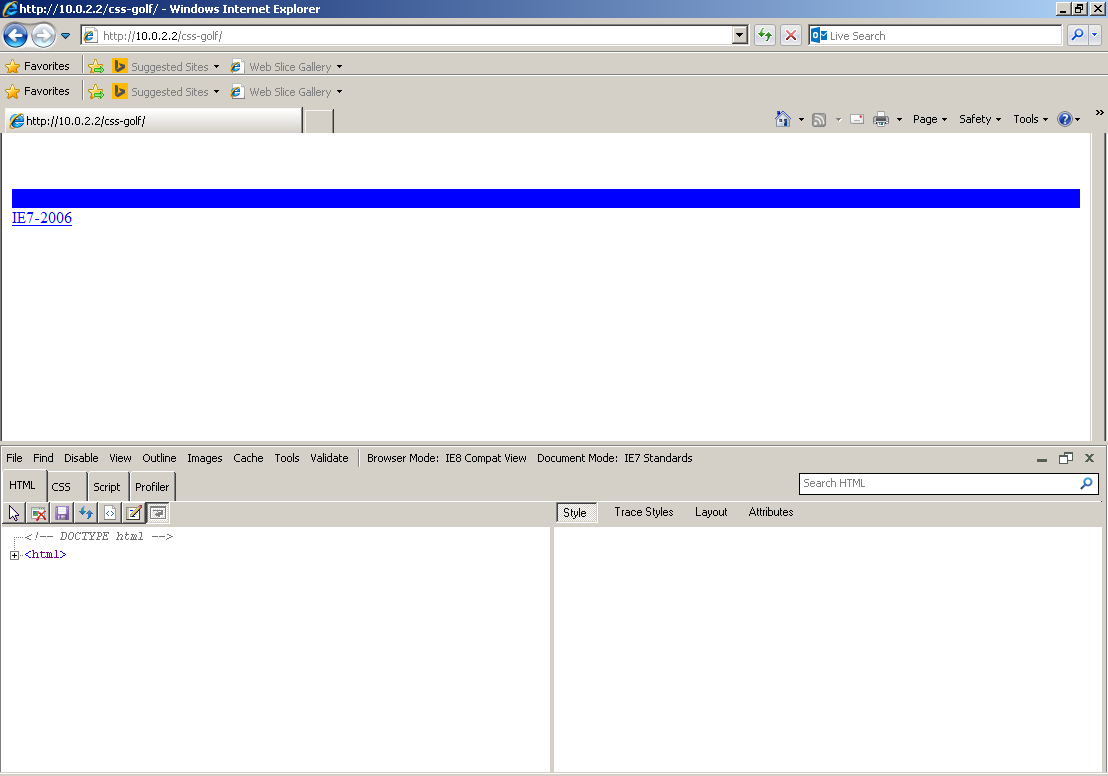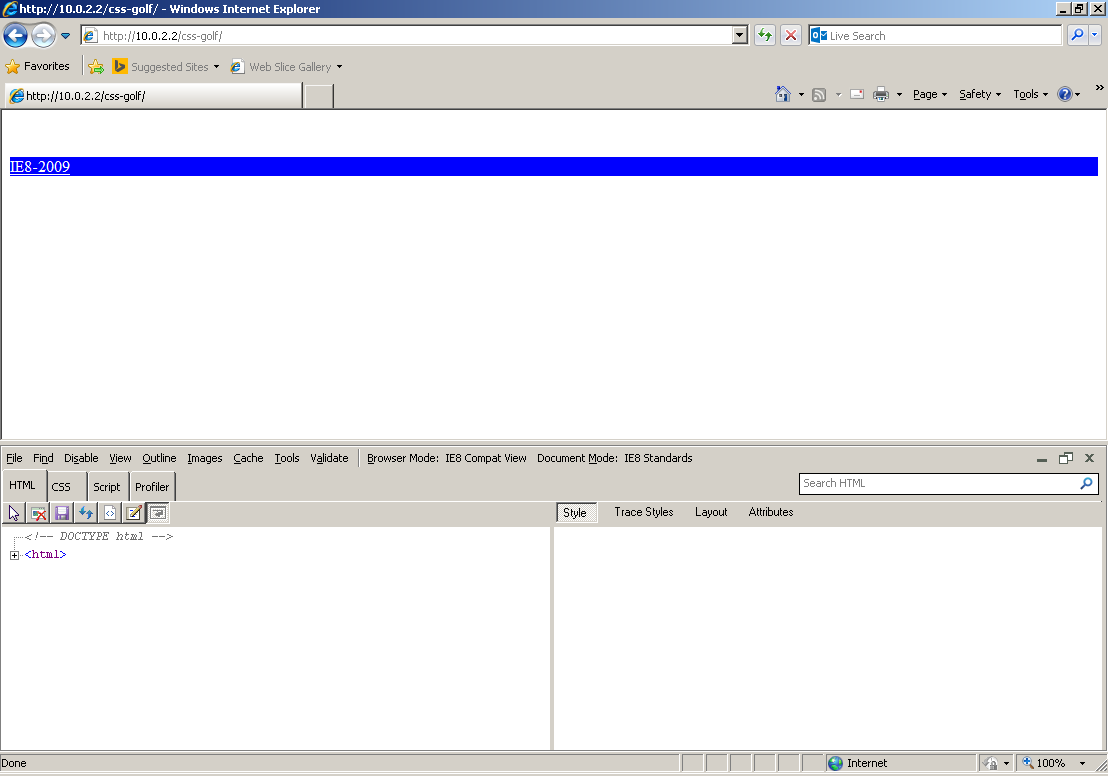7 years, 8 browsers
Not exactly language release dates because css doesn't actually have releases, but browser versions (could be thought as compiler versions maybe?)
For the following browsers, this prints the browser name, version and release date and nothing else. It does print the same thing for a few later versions, (you will see chromium is one version late in the screenshots because it's hard to download old versions of chrome by version number)
I could print the version number I used but I preferred to show the first version where the used feature is introduced.
- IE6
- IE7
- IE8
- IE9 (untested, don't have an IE9 around)
- Firefox 4
- Firefox 3.6
- Chrome 18
- Chrome 21
- Modern Browsers







index.html
<!DOCTYPE html>
<html>
<head>
<meta http-equiv="X-UA-Compatible" content="IE=edge">
<link rel=stylesheet href=style.css>
</head>
<body>
<div class=borderbox>
<div class="inlineblock">
IE6-2001
</div>
<div class="white">
<div class="outofbox">
<a href="#">IE8-2009</a>
</div>
<div class="inherit">
<a href="#">IE7-2006</a>
</div>
</div>
</div>
<div class="white">
<header class="filter-quirk filter-blur filter-blur-url">
IE9
</header>
</div>
<div class="flex white">
Modern Browsers - 2017
</div>
<div class="webkit-flex">
<div class="">
Chrome 21-2012
</div>
</div>
<div class="webkit-invert white flexdisable">
<div class="">
Chrome 18-2012
</div>
</div>
<svg style="position: absolute; top: -99999px" xmlns="http://www.w3.org/2000/svg">
</svg>
<div class="filter">
<svg xmlns="http://www.w3.org/2000/svg" version="1.1">
<g
transform="scale(8)"
aria-label="FF4"
id="text8419">
<rect
style="color:#000000;clip-rule:nonzero;display:inline;overflow:visible;visibility:visible;opacity:1;isolation:auto;mix-blend-mode:normal;color-interpolation:sRGB;color-interpolation-filters:linearRGB;solid-color:#000000;solid-opacity:1;fill:#ffffff;fill-opacity:1;fill-rule:nonzero;stroke:none;stroke-width:0.79374999;stroke-miterlimit:4;stroke-dasharray:none;stroke-dashoffset:0;stroke-opacity:1;marker:none;color-rendering:auto;image-rendering:auto;shape-rendering:auto;text-rendering:auto;enable-background:accumulate"
id="rect21965"
width="17.005648"
height="3.9855044"
x="-0.16825682"
y="-0.025296567" />
<path
d="m 1.0052634,1.5511362 v 0.7639843 h 0.4564063 q 0.092604,0 0.092604,0.066146 0,0.069453 -0.092604,0.069453 H 0.69107072 q -0.089297,0 -0.089297,-0.069453 0,-0.066146 0.089297,-0.066146 h 0.1785938 V 0.72431329 h -0.1785938 q -0.089297,0 -0.089297,-0.069453 0,-0.066146 0.089297,-0.066146 H 2.1793519 V 1.0484278 q 0,0.089297 -0.069453,0.089297 -0.066146,0 -0.066146,-0.089297 V 0.72431329 H 1.0052634 V 1.4155373 H 1.4848207 V 1.2667091 q 0,-0.089297 0.066146,-0.089297 0.069453,0 0.069453,0.089297 v 0.4332552 q 0,0.089297 -0.069453,0.089297 -0.066146,0 -0.066146,-0.089297 V 1.5511362 Z"
style="fill:#000000;stroke-width:0.79374999"
id="path8421" />
<path
d="m 2.9883464,1.5511362 v 0.7639843 h 0.4564063 q 0.092604,0 0.092604,0.066146 0,0.069453 -0.092604,0.069453 h -0.770599 q -0.089297,0 -0.089297,-0.069453 0,-0.066146 0.089297,-0.066146 H 2.8527475 V 0.72431329 H 2.6741537 q -0.089297,0 -0.089297,-0.069453 0,-0.066146 0.089297,-0.066146 H 4.1624349 V 1.0484278 q 0,0.089297 -0.069453,0.089297 -0.066146,0 -0.066146,-0.089297 V 0.72431329 H 2.9883464 V 1.4155373 H 3.4679037 V 1.2667091 q 0,-0.089297 0.066146,-0.089297 0.069453,0 0.069453,0.089297 v 0.4332552 q 0,0.089297 -0.069453,0.089297 -0.066146,0 -0.066146,-0.089297 V 1.5511362 Z"
style="fill:#000000;stroke-width:0.79374999"
id="path8423" />
<path
d="M 5.6692683,1.8917872 H 4.7729923 V 1.7363445 l 0.754062,-1.28322911 h 0.277813 V 1.7561883 h 0.112448 q 0.0893,0 0.0893,0.069453 0,0.066146 -0.0893,0.066146 h -0.112448 v 0.4233333 h 0.112448 q 0.0893,0 0.0893,0.066146 0,0.069453 -0.0893,0.069453 h -0.499402 q -0.0893,0 -0.0893,-0.069453 0,-0.066146 0.0893,-0.066146 h 0.251355 z m 0,-0.1355989 V 0.58871439 h -0.07938 L 4.9019713,1.7561883 Z"
style="fill:#000000;stroke-width:0.79374999"
id="path8425" />
<path
d="M 8.2881171,1.6077068 H 6.9585859 q -0.089297,0 -0.089297,-0.069453 0,-0.066146 0.089297,-0.066146 h 1.3295312 q 0.089297,0 0.089297,0.066146 0,0.069453 -0.089297,0.069453 z"
style="stroke-width:0.79374999"
id="path8422" />
<path
d="m 8.9582054,0.90656104 q 0,-0.14882812 0.1785937,-0.31749999 0.1819011,-0.17197916 0.4365625,-0.17197916 0.2414323,0 0.4233333,0.17197916 0.1852081,0.17197916 0.1852081,0.39687498 0,0.14882817 -0.0893,0.28111977 Q 10.006617,1.3960402 9.7056533,1.67716 L 9.0210439,2.3154672 v 0.00992 H 10.059533 V 2.2063266 q 0,-0.089297 0.06945,-0.089297 0.06614,0 0.06614,0.089297 V 2.460988 H 8.8920596 V 2.2625506 L 9.6725804,1.5283318 q 0.2315104,-0.2282031 0.3009635,-0.3307291 0.07276,-0.102526 0.07276,-0.21497396 0,-0.17197916 -0.1422132,-0.30096353 -0.1422136,-0.12898437 -0.3307292,-0.12898437 -0.1686718,0 -0.3075781,0.0992188 -0.1355989,0.0992188 -0.1752864,0.24804686 -0.019844,0.0661458 -0.069453,0.0661458 -0.023151,0 -0.042995,-0.0165365 -0.019844,-0.0198437 -0.019844,-0.0429948 z"
style="stroke-width:0.79374999"
id="path8424" />
<path
d="m 12.207981,1.3001287 v 0.3307292 q 0,0.3902604 -0.171979,0.6349999 -0.171979,0.2447396 -0.446484,0.2447396 -0.274506,0 -0.446485,-0.2447396 Q 10.971054,2.0211183 10.971054,1.6308579 V 1.3001287 q 0,-0.39356766 0.171979,-0.63830724 0.171979,-0.24473957 0.446485,-0.24473957 0.274505,0 0.446484,0.24473957 0.171979,0.24473958 0.171979,0.63830724 z M 11.589518,0.55268084 q -0.224896,0 -0.353881,0.22820312 -0.128984,0.22489584 -0.128984,0.53578124 v 0.2943489 q 0,0.3241146 0.132292,0.5457031 0.135599,0.2182813 0.350573,0.2182813 0.224895,0 0.35388,-0.2248959 0.128984,-0.2282031 0.128984,-0.5390885 V 1.3166652 q 0,-0.32411458 -0.135599,-0.54239582 -0.132292,-0.22158854 -0.347265,-0.22158854 z"
style="stroke-width:0.79374999"
id="path8426" />
<path
d="M 13.642054,0.43692564 V 2.3253891 h 0.459713 q 0.0893,0 0.0893,0.066146 0,0.069453 -0.0893,0.069453 h -1.055026 q -0.0926,0 -0.0926,-0.069453 0,-0.066146 0.0926,-0.066146 h 0.459714 V 0.61551938 l -0.373724,0.37372394 q -0.02646,0.0264584 -0.06945,0.0264584 -0.02646,0 -0.0463,-0.0198438 -0.01654,-0.023151 -0.01654,-0.056224 0,-0.0297656 0.03638,-0.0661458 l 0.436562,-0.43656248 z"
style="stroke-width:0.79374999"
id="path8428" />
<path
d="M 15.625137,0.43692564 V 2.3253891 h 0.459713 q 0.0893,0 0.0893,0.066146 0,0.069453 -0.0893,0.069453 h -1.055026 q -0.0926,0 -0.0926,-0.069453 0,-0.066146 0.0926,-0.066146 h 0.459714 V 0.61551938 l -0.373724,0.37372394 q -0.02646,0.0264584 -0.06945,0.0264584 -0.02646,0 -0.0463,-0.0198438 -0.01654,-0.023151 -0.01654,-0.056224 0,-0.0297656 0.03638,-0.0661458 l 0.436563,-0.43656248 z"
style="stroke-width:0.79374999"
id="path8430" />
</g>
</svg>
</div>
<div class="white gradient msfilter" style=color:white>
FF3.6-2010
</div>
</body>
</html>
style.css
.borderbox {
height: 40px;
overflow: hidden;
padding-bottom: 100px;
}
.outofbox {
background: blue none repeat scroll 0 0;
margin-top: 20px;
opacity: 0;
}
.white {
color: white;
}
.outofbox a, .inherit a, .inherit a:visited, .outofbox a:visited {
color: inherit;
}
.inlineblock {
display: inline;
width: 100%;
zoom: 1;
display: inline-block;
margin-left: 100px;
text-align: right;
}
.white header{
color: black;
}
.absolute{
position: absolute;
}
.flex{
display: none;
display: flex;
}
.flex.white{
filter: invert(100%)
}
.webkit-flex{
display: none;
display: -webkit-flex;
overflow: hidden;
flex-flow: column;
height: 3em;
justify-content: flex-end;
}
.webkit-flex div{
margin-bottom: -1.1em;
}
.flexdisable{
display: -webkit-flex;
overflow: hidden;
-webkit-flex-flow: column;
-webkit-justify-content: flex-end;
height: 60px;
}
.flexdisable div{
margin-bottom: -30px;
}
.filter-quirk{
filter: url(#quirk);
}
.filter-blur{
filter: blur(100px);
-webkit-filter: blur(100px);
}
.webkit-blur{
-webkit-filter: blur(100px);
}
.webkit-invert{
-webkit-filter: invert(100%);
filter: none;
}
.filter-url-dark{
-webkit-filter: url(filter.svg#Invert);
filter: url(filter.svg#Invert) invert(100%);
}
.filter-blur-url{
filter: url(filter.svg#blur) url(filter.svg#brightness);
}
.filter{
filter: invert(100%) brightness(100%);
-webkit-filter: invert(100%) brightness(100%) blur(100px);
}
.filter svg{
position: absolute;
}
.filter svg rect{
filter: invert(100%);
-webkit-filter: invert(100%);
}
.msfilter{
/* IE 8 */
-ms-filter: "progid:DXImageTransform.Microsoft.Alpha(Opacity=0)";
/* IE 5-7 */
filter: alpha(opacity=0);
}
.opacity{
}
.black{
background: black;
}
.gradient{
width: 100px;
background: -moz-linear-gradient( 45deg, #000, #000 );
font-weight: bold;
}
filter.svg
<!DOCTYPE html>
<html>
<head>
<meta http-equiv="X-UA-Compatible" content="IE=edge">
<link rel=stylesheet href=style.css>
</head>
<body>
<div class=borderbox>
<div class="inlineblock">
IE6-2001
</div>
<div class="white">
<div class="outofbox">
<a href="#">IE8-2009</a>
</div>
<div class="inherit">
<a href="#">IE7-2006</a>
</div>
</div>
</div>
<div class="white">
<header class="filter-quirk filter-blur filter-blur-url">
IE9
</header>
</div>
<div class="flex white">
Modern Browsers - 2017
</div>
<div class="webkit-flex">
<div class="">
Chrome 21-2012
</div>
</div>
<div class="webkit-invert white flexdisable">
<div class="">
Chrome 18-2012
</div>
</div>
<svg style="position: absolute; top: -99999px" xmlns="http://www.w3.org/2000/svg">
</svg>
<div class="filter">
<svg xmlns="http://www.w3.org/2000/svg" version="1.1">
<g
transform="scale(8)"
aria-label="FF4"
id="text8419">
<rect
style="color:#000000;clip-rule:nonzero;display:inline;overflow:visible;visibility:visible;opacity:1;isolation:auto;mix-blend-mode:normal;color-interpolation:sRGB;color-interpolation-filters:linearRGB;solid-color:#000000;solid-opacity:1;fill:#ffffff;fill-opacity:1;fill-rule:nonzero;stroke:none;stroke-width:0.79374999;stroke-miterlimit:4;stroke-dasharray:none;stroke-dashoffset:0;stroke-opacity:1;marker:none;color-rendering:auto;image-rendering:auto;shape-rendering:auto;text-rendering:auto;enable-background:accumulate"
id="rect21965"
width="17.005648"
height="3.9855044"
x="-0.16825682"
y="-0.025296567" />
<path
d="m 1.0052634,1.5511362 v 0.7639843 h 0.4564063 q 0.092604,0 0.092604,0.066146 0,0.069453 -0.092604,0.069453 H 0.69107072 q -0.089297,0 -0.089297,-0.069453 0,-0.066146 0.089297,-0.066146 h 0.1785938 V 0.72431329 h -0.1785938 q -0.089297,0 -0.089297,-0.069453 0,-0.066146 0.089297,-0.066146 H 2.1793519 V 1.0484278 q 0,0.089297 -0.069453,0.089297 -0.066146,0 -0.066146,-0.089297 V 0.72431329 H 1.0052634 V 1.4155373 H 1.4848207 V 1.2667091 q 0,-0.089297 0.066146,-0.089297 0.069453,0 0.069453,0.089297 v 0.4332552 q 0,0.089297 -0.069453,0.089297 -0.066146,0 -0.066146,-0.089297 V 1.5511362 Z"
style="fill:#000000;stroke-width:0.79374999"
id="path8421" />
<path
d="m 2.9883464,1.5511362 v 0.7639843 h 0.4564063 q 0.092604,0 0.092604,0.066146 0,0.069453 -0.092604,0.069453 h -0.770599 q -0.089297,0 -0.089297,-0.069453 0,-0.066146 0.089297,-0.066146 H 2.8527475 V 0.72431329 H 2.6741537 q -0.089297,0 -0.089297,-0.069453 0,-0.066146 0.089297,-0.066146 H 4.1624349 V 1.0484278 q 0,0.089297 -0.069453,0.089297 -0.066146,0 -0.066146,-0.089297 V 0.72431329 H 2.9883464 V 1.4155373 H 3.4679037 V 1.2667091 q 0,-0.089297 0.066146,-0.089297 0.069453,0 0.069453,0.089297 v 0.4332552 q 0,0.089297 -0.069453,0.089297 -0.066146,0 -0.066146,-0.089297 V 1.5511362 Z"
style="fill:#000000;stroke-width:0.79374999"
id="path8423" />
<path
d="M 5.6692683,1.8917872 H 4.7729923 V 1.7363445 l 0.754062,-1.28322911 h 0.277813 V 1.7561883 h 0.112448 q 0.0893,0 0.0893,0.069453 0,0.066146 -0.0893,0.066146 h -0.112448 v 0.4233333 h 0.112448 q 0.0893,0 0.0893,0.066146 0,0.069453 -0.0893,0.069453 h -0.499402 q -0.0893,0 -0.0893,-0.069453 0,-0.066146 0.0893,-0.066146 h 0.251355 z m 0,-0.1355989 V 0.58871439 h -0.07938 L 4.9019713,1.7561883 Z"
style="fill:#000000;stroke-width:0.79374999"
id="path8425" />
<path
d="M 8.2881171,1.6077068 H 6.9585859 q -0.089297,0 -0.089297,-0.069453 0,-0.066146 0.089297,-0.066146 h 1.3295312 q 0.089297,0 0.089297,0.066146 0,0.069453 -0.089297,0.069453 z"
style="stroke-width:0.79374999"
id="path8422" />
<path
d="m 8.9582054,0.90656104 q 0,-0.14882812 0.1785937,-0.31749999 0.1819011,-0.17197916 0.4365625,-0.17197916 0.2414323,0 0.4233333,0.17197916 0.1852081,0.17197916 0.1852081,0.39687498 0,0.14882817 -0.0893,0.28111977 Q 10.006617,1.3960402 9.7056533,1.67716 L 9.0210439,2.3154672 v 0.00992 H 10.059533 V 2.2063266 q 0,-0.089297 0.06945,-0.089297 0.06614,0 0.06614,0.089297 V 2.460988 H 8.8920596 V 2.2625506 L 9.6725804,1.5283318 q 0.2315104,-0.2282031 0.3009635,-0.3307291 0.07276,-0.102526 0.07276,-0.21497396 0,-0.17197916 -0.1422132,-0.30096353 -0.1422136,-0.12898437 -0.3307292,-0.12898437 -0.1686718,0 -0.3075781,0.0992188 -0.1355989,0.0992188 -0.1752864,0.24804686 -0.019844,0.0661458 -0.069453,0.0661458 -0.023151,0 -0.042995,-0.0165365 -0.019844,-0.0198437 -0.019844,-0.0429948 z"
style="stroke-width:0.79374999"
id="path8424" />
<path
d="m 12.207981,1.3001287 v 0.3307292 q 0,0.3902604 -0.171979,0.6349999 -0.171979,0.2447396 -0.446484,0.2447396 -0.274506,0 -0.446485,-0.2447396 Q 10.971054,2.0211183 10.971054,1.6308579 V 1.3001287 q 0,-0.39356766 0.171979,-0.63830724 0.171979,-0.24473957 0.446485,-0.24473957 0.274505,0 0.446484,0.24473957 0.171979,0.24473958 0.171979,0.63830724 z M 11.589518,0.55268084 q -0.224896,0 -0.353881,0.22820312 -0.128984,0.22489584 -0.128984,0.53578124 v 0.2943489 q 0,0.3241146 0.132292,0.5457031 0.135599,0.2182813 0.350573,0.2182813 0.224895,0 0.35388,-0.2248959 0.128984,-0.2282031 0.128984,-0.5390885 V 1.3166652 q 0,-0.32411458 -0.135599,-0.54239582 -0.132292,-0.22158854 -0.347265,-0.22158854 z"
style="stroke-width:0.79374999"
id="path8426" />
<path
d="M 13.642054,0.43692564 V 2.3253891 h 0.459713 q 0.0893,0 0.0893,0.066146 0,0.069453 -0.0893,0.069453 h -1.055026 q -0.0926,0 -0.0926,-0.069453 0,-0.066146 0.0926,-0.066146 h 0.459714 V 0.61551938 l -0.373724,0.37372394 q -0.02646,0.0264584 -0.06945,0.0264584 -0.02646,0 -0.0463,-0.0198438 -0.01654,-0.023151 -0.01654,-0.056224 0,-0.0297656 0.03638,-0.0661458 l 0.436562,-0.43656248 z"
style="stroke-width:0.79374999"
id="path8428" />
<path
d="M 15.625137,0.43692564 V 2.3253891 h 0.459713 q 0.0893,0 0.0893,0.066146 0,0.069453 -0.0893,0.069453 h -1.055026 q -0.0926,0 -0.0926,-0.069453 0,-0.066146 0.0926,-0.066146 h 0.459714 V 0.61551938 l -0.373724,0.37372394 q -0.02646,0.0264584 -0.06945,0.0264584 -0.02646,0 -0.0463,-0.0198438 -0.01654,-0.023151 -0.01654,-0.056224 0,-0.0297656 0.03638,-0.0661458 l 0.436563,-0.43656248 z"
style="stroke-width:0.79374999"
id="path8430" />
</g>
</svg>
</div>
<div class="white gradient msfilter" style=color:white>
FF3.6-2010
</div>
</body>
</html>












